RICHARD PENDLEBURY watches the fierce battle unfold in a huge, bloodied coliseum and sees Israel’s reckoning with Hamas on the Gaza Strip border come to life.
Like an orchestra reaching crescendo, every war instrument is in full voice.
Machine guns rattle, artillery crashes and the air flutters as a nearby Merkava tank fires again and again.
There is no rest for the senses, let alone for the targets on the other side. The effect is both awe-inspiring and terrifying. We are standing on a hill, on the edge of the evacuated Israeli town of Sderot, which was overrun by Hamas terrorists in their killing spree just over three weeks ago. Now we are witnessing a small part of the reckoning.
Just a few hundred meters away, across the border from the Gaza Strip, the Israeli Defense Forces (IDF) have begun the ground operation that they say will destroy Hamas forever.
We can watch them from here, like spectators in the back row of a huge and bloody coliseum.
Israeli soldiers prepare for ground maneuvers at a secret location near the Gaza border
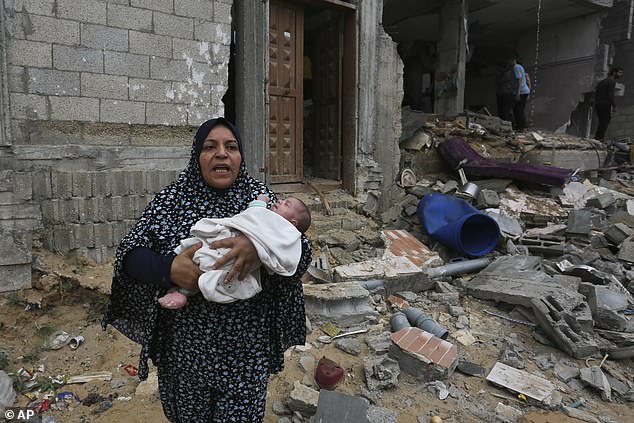
Palestinians evacuate a building destroyed during the Israeli bombardment of the Gaza Strip, including in the southern border town of Rafah
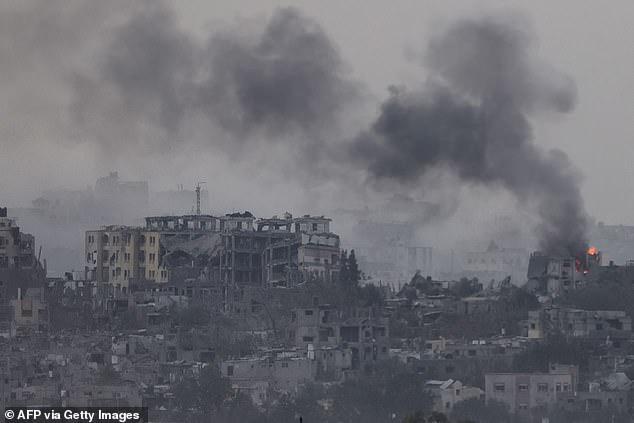
Smoke rises after the Israeli bombardment of the northern Gaza Strip on Sunday
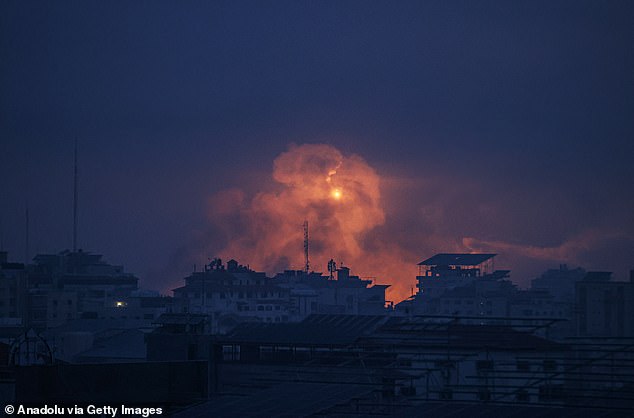
A huge fireball is seen rising over Gaza City after intense Israeli attacks
The day is hot and foggy. In the distance rise the tower blocks of Beit Hanoun, the closest city in northern Gaza to the Israeli advance. Heavy fighting appears to be taking place in the open countryside between the Erez border crossing – which was also overrun by Hamas on October 7 – and the urban edges of Gaza. A cloud of dust hangs over Beit Hanoun as if someone has just shaken a giant dusty carpet, while columns of foul smoke rise from where the artillery and aerial bombs are hitting us.
Overhead, the constant whine of drones and the roar of fast planes complete the cacophony. I can only report what I see from this position. The IDF is not yet inviting correspondents to take a closer look at their operation.
When you look at this cauldron of violence, you can imagine what will happen when the fighting starts from street to street.
About two million Palestinian non-combatant civilians remain trapped in Gaza. Hamas authorities say 8,000 have already been killed.
Vignettes present themselves as the fog of war briefly lifts. An armored vehicle maneuvers in a field at medium range and you can see muzzle flashes as it fires at an unknown target.
Then at the same location, which is partially hidden by a stand of trees, something begins to burn steadily, releasing thick, dark smoke for more than an hour. The tank? No, it looks like a farm building and vegetation. The mist closes again.
As dusk falls, a pinprick of brilliant orange speed sweeps across the battlefield from north to south; perhaps one of the anti-tank guided missiles the IDF claims has been used against their forces.
More rocket fire leaves zigzag trails and a fresh carpet of smoke. Then a huge flash between the tall buildings and a billowing column of dark smoke, followed by the sound of a departing plane.
The blood rises, everywhere.
Colonel Elad Zuri, the commander of Israel’s 7th Armored Brigade, gave this speech over the car radios to his tank crews on Saturday evening as they pushed into the Gaza Strip: ‘Fifty years after the Yom Kippur War, we stand here, at the gates of Gaza.
“On the eve of Simchat Torah (the Jewish festival that took place on October 7), Hamas terrorists broke into communities around the Gaza Strip and carried out a horrific massacre.
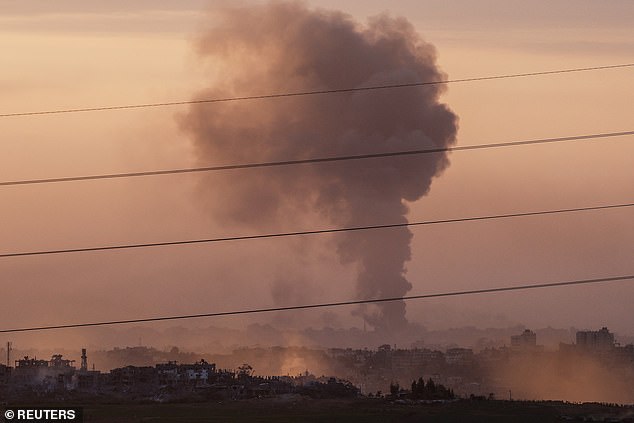
The evening sky over Gaza is filled with smoke from continued Israeli bombardments
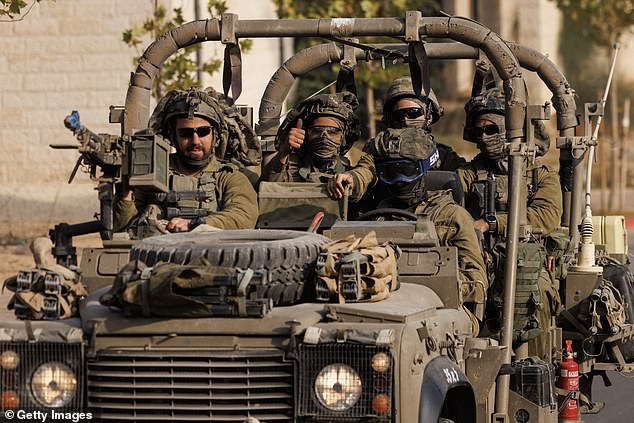
An Israeli soldier gives a thumbs up as Israeli troops approach the Gaza border on Saturday

Palestinians injured in Israeli airstrikes arrive at Nasser Medical Hospital on Sunday
‘We (the 7th Brigade took part in the fighting of October 7) fought bravely, without regard for our own safety, to defend the civilians. Brigade, this is your commander speaking. The time has come. We will show the enemy that we are the crushing brigade. We will seek and destroy the enemy wherever he runs, until victory. The people of Israel believe in us. I believe in us. Units of Brigade 7, this is your commander. Move forward towards your goals. Firework!’
Idit is the wife of one of those tank crew members. I met her early yesterday at a refugee center on the shores of the Sea of Galilee, where she was evacuated from her kibbutz on the Lebanese border with their six-year-old son Eitan. Her reservist husband Oded was mobilized the day the Hamas massacres began.
Now he’s driving into Gaza. Init, a psychologist, had to leave her home with only the clothes she currently wears.
She says of the situation in Gaza: “This is unlike anything that has happened before. This (war) is not soldiers against soldiers. They are monsters against children.
‘I must say that before October 7 I thought very differently. I wanted peace. My husband laughed at me.
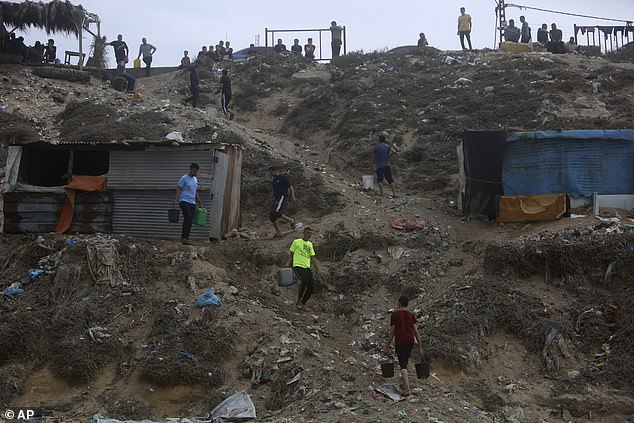
Palestinians collect buckets of water from the sea on Sunday due to the ongoing water shortage in the Gaza Strip
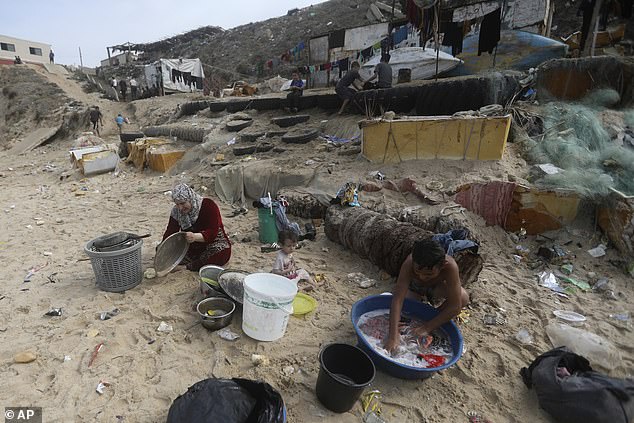
Palestinians resort to using the seawater to bathe and clean their tools and clothes amid Gaza Strip’s water shortage
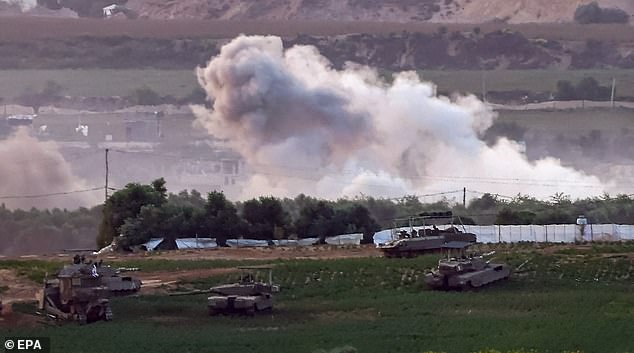
Israeli tanks were photographed in the northern part of the Gaza Strip on Sunday
“Israel is now saying to the people of Gaza: ‘Get out of your homes before they are bombed.’ But no one said to the people of the kibbites in the south, ‘Get out of your house before we come.’
‘They wanted to kill children. They wanted to kill women like me.
“I don’t want innocent civilians and children to get hurt, but there are repercussions for what their people did to my people. I’m not interested in a ‘who is the most miserable competition’. But this was caused by Hamas.”
The past three weeks have hardened opposing views, turned peacemakers into warmongers and threaten to destroy any chance of Israel further “normalizing” ties with the Arab world. That was certainly Hamas’ goal.
But Benjamin Netanyahu is also a divisive prime minister who will have a lot of explaining to do if and when the dust settles. Israelis have noted how haggard he has looked since the start of this crisis.
Yet he remains a master of rhetorical flourishes. Last weekend he labeled this national disaster Israel’s “second war of independence.”
In other words: the country must rally behind him. As for the ground offensive in Gaza, all bets are off. This orchestra is just tuning.
